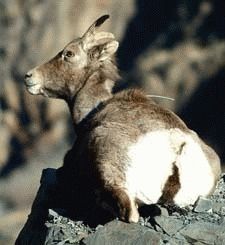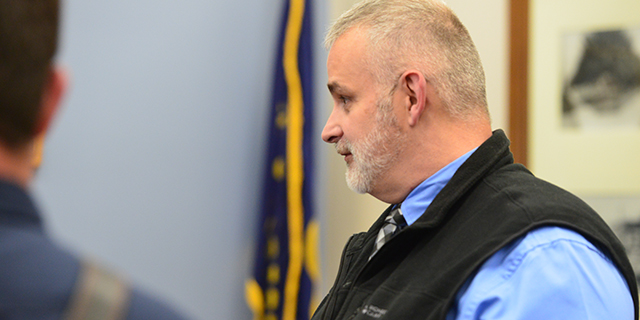BELEAGUERED BIGHORNS BATTLE FOR SURVIVAL
Published 12:00 am Friday, December 13, 2002

- COLLARED: This Rocky Mountain bighorn sheep wears a radio collar so its whereabouts can be monitored by wildlife biologists from the Oregon Department of Fish and Wildlife. The collar's antenna sticks out at the animal's right. (Hells Canyon Journal photo/STEVE BACKSTROM).
By Steve Backstrom
Trending
For The Observer
HALFWAY
Perhaps you’ve seen them, working their way up the rocky, vertical walls of Hells Canyon feet firmly anchored in cracks and on nubs that human eyes can’t identify as footholds, and climbing those invisible nubs and cracks as casually as a person climbs a flight of stairs.
Trending
The Rocky Mountain bighorn sheep possess a grace and majesty that matches the wild beauty of the country they inhabit.
But their grip on life may be more tenuous than their footholds on the invisible cracks of a basalt cliff. Two of the three bands of bighorns that inhabit the local reaches of the Snake River have serious problems with pneumonia. And while the third band appears to be disease-free, contact with infected wild sheep or disease-carrying domestic sheep may be just a matter of time.
Known by the name of the reservoirs closest to their home territory, the members of the Brownlee, Oxbow and Hells Canyon bands of wild sheep are closely monitored by biologists from the Oregon Department of Fish and Wildlife. Radio collars enable biologists to keep track of the survival and whereabouts of various individual herd members. Most of the bighorns along the river have been transplanted from other locations, and the most recent transplants have been outfitted with radio collars.
andamp;quot;We had a release in the Leep Creek area, downstream from McGraw Creek, in 1999,andamp;quot; said George Keister of ODFW’s Baker City office. andamp;quot;There were 15 sheep, all from the Lostine and all with radio collars.andamp;quot;
andamp;quot;The next summer we had disease show up in the herd at Oxbow. We’ve lost over half the adults in that herd since then, most in the first summer and winter after the disease became apparent. That first summer, two lambs survived. The next summer, out of 15 lambs we had zero survival; the following summer it was the same story.andamp;quot;
Keister says the lambs are born healthy, but their mothers are carriers of pneumonia, which initially worked its way into wild populations from infected domestic sheep. The bighorn lambs survive as long as they’re nursing. They get immunity to the disease from their mothers’ colostrum, but once they’ve been weaned, they die.
andamp;quot;In mid-May, we’ll have 15 lambs and by mid-June, they’re dead,andamp;quot; said Keister. andamp;quot;This past summer, the lambs survived longer.andamp;quot;
The herd on Brownlee Reservoir, loosely centered in the vicinity of Conner Creek, has fared better. The herd at Hells Canyon, which is monitored by biologists from Enterprise rather than Baker City, has had bouts of pneumonia which seem to come and go.
Keister would normally be taking a census of sheep by helicopter at this time of year, to see if any of this year’s babies beat the odds and survived or if any more adults have died.
The state’s budget crunch has grounded its wildlife biologists, so they don’t know how many bighorns have survived. Keister hopes to count bighorns from the air by next spring. For now, radio collars can provide a wealth of information about the animals’ travels.
andamp;quot;There was one little ram from the Leep Creek group that went to Idaho the next spring after the transplant. He went up to the Seven Devils. He did that two different years and came back to Oregon in the winters,” Keister said.
andamp;quot;The summer before last, he went up to the Lakes Basin in the Eagle Caps. In the fall, he came back down with another little ram and went right through Halfway. He was reported on the hill between Halfway and Richland, right by the highway. I came out the next day to track him, but by that time, he’d gone down to Brownlee Reservoir and crossed over to the Idaho side.
andamp;quot;This past summer, he went back up to the Eagle Caps and died there.andamp;quot;
The radio collars have a andamp;quot;mortality signalandamp;quot; that alerts biologists to the demise of a collared animal. The cause of death of the free-spirited little ram, which was sighted last year on the Cornucopia Highway, isn’t known. But when trackers found the carcass, its head had been removed.
Whether the bighorns along the Snake River can endure, only time will tell, biologists say. Through the use of radio collars and aerial population surveys, biologists can at least monitor the bighorns’ battle for survival.
Steve Backstrom is editor and publisher of the Hells Canyon Journal in Halfway.








